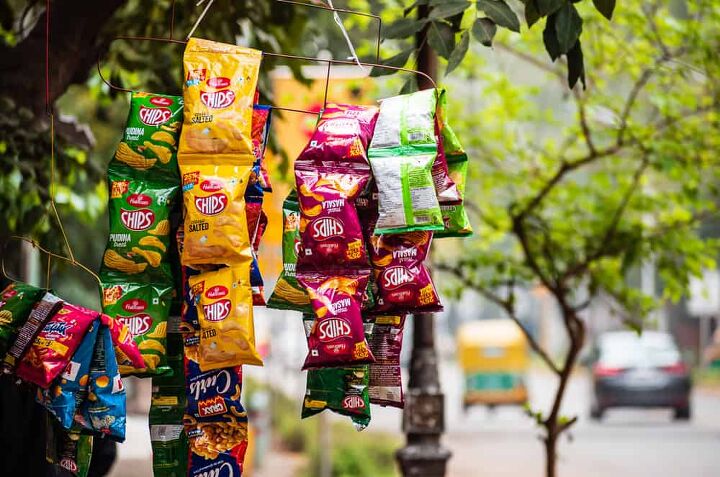How To Organize A Corner Pantry (6 Ways To Do It!)

Corner pantries are meant to be a major part of your kitchen’s storage. It’s usually where extra food goes, and where you can expect your other less-used kitchen tools to go. If you’re a foodie like me, that usually means that you’re a little overwhelmed when you see how much stuff you have to fit into a corner pantry. Is there any way to make organizing this easier?
Organizing a corner pantry is something that you get to choose how to do. Most organization experts note that there are several ways you can clean up your pantry in a pinch. These include:
- Having A Bag Storage Rack
- Use Stackable Bins
- Add Drawers
- Hang Snacks And Tools On A Peg Board
- Add A Lazy Susan
- Store Items In A Shoe Tree
Trying to add a little order to your corner pantry can be hard, especially if you’re not used to getting stuff organized on your own. This guide will help you make the most of your storage space with five easy tricks.
The Best Ways To Organize A Corner Pantry
Your corner pantry is going to be short on space, so the best way to make sure you can store more is to have some stuff help you out. Let’s take a look at the easiest ways to make your pantry feel larger.
1. Having A Bag Storage Rack
We all have seen stores that had racks where they would clip chip bags for sale up on a small wire or metal bar. These are bag-hanging racks, and they’re pretty easy to make on your own. All you need to do is glue clothespins to a ruler, really. If you are a frequent snacker or have stuff that needs to be hung up, having some bag racks can help you do it fast.
This is a great way to make use of wall space that would otherwise go unused. If you don’t have wall space, you can glue the ruler to the edge of a shelf, or create a bag shelf that hangs from the ceiling.
2. Use Stackable Bins
Most of us have at least two items that we buy in bulk—sugar, barley, flour…You get the idea. If you have a lot of stuff you want to store in large quantities, the best thing you can do is go to your local major home improvement store and get a bunch of stackable bins. Put each of your bulk items in a box of its own,
To make sure that you get the best results (and don’t mix flour for powdered sugar), make sure to label each plastic bin. We suggest getting cute labels. Make sure they’re all facing you so you don’t grab the wrong bin!
3. Add Drawers
Drawers are a great way to make sure that you don’t end up with forgotten spices or cans of food at the back of your pantry. There are several ways to make your shelves into drawers. While there are kits that let you get the full-on wooden drawers on rails that you can use, you don’t always have to do this. Sometimes, getting fabric bins that you can pull out with ease works just as well.
Fabric drawers work well if you have a lot of dish towels or cleaning supplies you want to put together. Otherwise, getting pull-out drawers can help more. Want to keep your drawers organized? Get drawer separators to add an extra boost.
4. Hang Snacks And Tools On A Pegboard
One of the easiest ways to transform a pantry wall is to add a pegboard. This is a great way to add a place to hang everything from chips, to ladles, to magazines with cute recipes you want to make. People who tend to store odds and ends in their pantry will want to get a bunch of hangable accessories for them to use.
Most of the things that you can store here are the type of things that come with a ring or a hole to hang on, such as ladles, colanders, and even measuring cups. If you’re the type of person who tends to treat a pantry like a culinary toolshed, this is your best option.
5. Add A Lazy Susan
Lazy susans are a great addition to any corner pantry, especially if you’re a huge fan of spices and flavoring. These are spinning discs that allow you to display all of your goods with ease. To access them, all you have to do is turn the lazy susan so that the item you want to have faces you.
If you’re the type of person who tends to stack cans in areas that you later forget about, this is an absolute must-have. With that said, the big detractor is that you can’t use as much of your shelving space with these. However, most people find that the payout is amazing regardless of the lost space.
6. Store Items In A Shoe Tree
Remember these old-school additions? We’ve all seen them hanging off of doors, but they are useful for so many other things aside from shoes. If you have extremely large quantities of spices and don’t have much room in the actual pantry itself, a shoe tree like the one above can turn your door into a de facto spice rack.
This is a solution that works for all kitchen sizes, even tiny ones found in single-bedroom apartments. If you are not sure what your pantry can afford in terms of space, this is a sure shot. Admittedly, this is not the most aesthetic option around, but it’ll work in a pinch.
Important Tips To Remember When You’re Organizing Your Pantry
Pantry organizing is 60 percent organizational tools, and 40 percent common sense. (Yes, I made up those statistics, but the general idea is true.) The tips below will help maximize your efficiency:
- Label everything. This is a must, and we’ve mentioned it several times, but it’s worth noting. And, to make labeling easier, consider getting pretty DIY labels or printable labels for jars and bottles. It’ll make your labeling neater. If you aren’t a fan of labels glued to everything, get pre-labeled jars and bins. They exist!
- Don’t hesitate to add your own aesthetic touch. A pantry might be a storage place, but that doesn’t mean that you need to make it look drab. Getting a little paint, adding some nice decals, and even adding extra light can all help you make your pantry more usable.
- If you have a pest problem, stick to plastic and metal containers. This is the best way to deter mice from eating your food. It’s also a good way to make sure you can move stuff around in a pinch for cleaning/spraying purposes.
- Mix and match storage items. You don’t have to stick to a full array of plastic bins. Sometimes, adding jars, boxes, and other goods can spice things up…figuratively, I mean.
- Remember to work with the type of stuff you store. A pantry that is primarily made for cans is going to look different than a pantry for a family that has a bunch of cereal fiends. This, too, will look different from a pantry that’s heavy on spices. Keep in mind what you store the most of.
Related Questions
What should you do if you don’t have a pantry?
There are several ways that you can create your own pantry, aside from using the cabinets in your kitchen. One of the best ways to make your own pantry is to get a bookcase or a similar shelving unit, then outfit it with equipment that helps you store everything. Most metal garage table storage units are great for this purpose.If you have a larger kitchen without a pantry, you can also establish a nook that you separate out via shelving units. To give it its own “room,” you can use room dividers or put up a quick curtain. This gives you the illusion of another room.
Does a pantry need to have ventilation?
Like any other part of your home, your kitchen pantry will need some level of ventilation in order to be truly functional. The truth is that ventilation does a lot for both the quality of your home’s materials as well as food safety. Good ventilation will keep your food dry, prevent mold from growing, and also help ensure that the parts of your pantry that keep the woodwork stable remain in top shape.Pantries that are not ventilated will be more prone to mold growth, food rot, as well as odors that cling to the walls. So, if you want to keep your pantry fresh, you want to make sure that you have some vents.
Does a pantry really need a door?
Pantries traditionally always had a door to cover them, but the truth is that this isn’t a mandatory part of any pantry. Most pantries have cupboards with doors, so it’s not like you need a door to access the door. So, if you don’t want to have a door, don’t keep your door to your pantry. In most cases, removing the door will just add more ventilation.

Ossiana Tepfenhart is an expert writer, focusing on interior design and general home tips. Writing is her life, and it's what she does best. Her interests include art and real estate investments.
More by Ossiana Tepfenhart

















![10 Best Zero Turn Mowers – [2022 Reviews & Ultimate Buyer's Guide]](https://cdn-fastly.upgradedhome.com/media/2023/07/31/9070522/10-best-zero-turn-mowers-2022-reviews-ultimate-buyer-s-guide.jpg?size=350x220)















